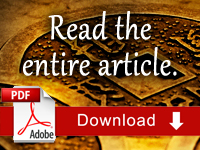Guideways Articles
Reflect new approaches developed over the last ten years in the creation of the Guideways for Change translations, fully illustrated by the Paper Horses.
Entering the Symbolic Life
Jung said that we need a Symbolic Life is the crisis of our times for without it we can never step out of “this awful, grinding, banal life where we are nothing but.” The symbols of the I Ching give us a portrait of these times: A crisis that combines real danger and the opportunity to come out of the prisons that trap our minds. Each of us is a makeweight in this great cultural change. Jung felt that a dialogue with the unseen world of the symbols is what could “set us right.” The experience of ancestors in traditional cultures is an image of this creative relation to the psyche, a hidden language that lets us respond once more to the beauty and the mystery of the world that surrounds us. This language is found in the Classic of Change. Jung felt that the “whole practical use of the I Ching” was an “answer to the West’s spiritual needs” (CW13, §72), for opens a space where the transformative energy of the symbols can arise freely and spontaneously in the heart.
Keywords of Change: The World of Words and Ideas behind the Practice of the Classic of Change
This is a lexicon of Change that introduces the ideas and practices central to the world of Change through the old Chinese pictographs that embody them. These ideas and practices permeated the old culture as ideals, rituals, characteristic ways of thinking and important experiences.
Mirror of Divination
This gives a background to divination as a unique Way of Knowing that opens the Mythological Memory or Sage-Mind. Traditional diviners call this “talking with spirits.” It provides understanding, enlightenment, a sense of unity and personal integration. The keys are the symbols that join present to past and future in a new and living relation.
Paper Horses: An Illustrated Journey through the Ritual World of Change
Paper Horses (mazhang), also called “spirit-money,” are wood-cut prints and paper objects offered to the Ghosts and Spirits and the Ancestors. A ubiquitous part of the bedrock religious practice of traditional East Asian people, they carry vivid images shaped by the symbols of the Classic of Change. Used ritually, they re-open the old East Asian sacred cosmos that acted as a place of close encounter with the spirit world. The ritual journey of the Paper Horses as they spring from the fire proceeds through the Eight Spirit Helpers, the eight trigrams of the Classic of Change. They open a space in our lives for the Ancestral Voices.
Returning to the Well
Yeats’ poem, “The Second Coming” and the symbol of the Well give us a portrait of our times that combines danger and the chance to come out of what Blake called the “mind-forged manacles” that lock us in our greed and need. This is the purpose of The Well, to return us to our common humanity and transform the prisons of “spin.” Jung called this introverting libido, when the stream of our lives turns inward and activates the depths of the psyche. Here we learn that our prisons are embedded thought-demons that block the deep river of symbols. The Well invokes the ji or hidden triggers that actualize individual beings by connecting them with ancestral potential. It is a ritual process that transforms mind and body, eliminating our heritage of pain and rage. This is the central mystery of divination, to experience something and be set right. It is can, in Jung’s words, work a profound transformation of our thought.
Rites of Passage I
I Ching embodies the rituals that are the sources of the wisdom of the East. Their symbols are fish-traps for Dao, a reflection of the holographic modeling capacity of the mythological mind. These symbols constitute the divine drama of our existence, rites or ceremonies that are stepping-stones to new cultural activities. They are a ritual experience of death, re-organization and re-birth. The passage from one state of being to another has three stages or steps. In the phase of Separation, we are severed from the familiar and fall into the fertile darkness. In the Transition phase our identity is opened to the inner field of actors and hidden spirit operators. In Incorporation we are oriented to the new stage of life. These processes represent a surrender of the drive toward rational meaning and heroic striving. They open a space in the heart where the transformative energy of the symbols can arise freely and spontaneously.
Rites of Passage II: Night Fires
Night Fires is a nocturnal ritual that occurs at the crucial point in the Transition stage of a Rite of Passage. The ritual makes us aware of the thought demons that haunt our mind, the hidden patterns of past pain, sorrow, rage and need and the psycho-physical roots embedded in our body that power them. The ritual process releases images from the literalization of the flesh, freeing the Bright Omen imprisoned in our embodied memories. This is the healing of an ancestral wound, releasing the bright spirit from the Ghost River of past pain and integrating it into the Dream Body.
The Heart of Change: The Rang Ritual of Giving Away
The journey to the heart of Change begins with the old Chinese character rang/jang and the ancient ritual of “acquiring something to give and giving it away in order to truly have it”. The Rang Ritual is embodied in the Pair 41:42 The Offering and the Blessing and a gesture that shows two open hands, palms up, that cede the way to others. Its inner drive is to pass the participant through 27 The Tiger’s Mouth. It is the basis of all rituals practiced in the Mourning Hut and theChan ritual at the high point of a dynasty that “renews our virtue by giving it away” (11:12). 41:42 shows this ritual as the Gate to the stage of life when we emerge into higher levels of spirit and empowerment in society. Another Rang Ritual inscribed on the last Line of Change (64.6) acts as the Approach to the birth into the life of the spirit.
The Hidden Triggers of Change
There are times we feel that everything we depend on is dissolving. In Change this is called 59 Huan/Dispersing and the Hidden Triggers appear at its inner center. The old ji-character in this omen is a “hundun word” that deconstructs our civilized identity. It is a Strange Attractor where the “names” of things dissolve, opening a connection to the two feminine spirit-intermediaries that express soul connections. The old diviners articulated this “hole that reveals the (w)hole”. We see it in Jung’s sense of Dao as a “creatio ex nihilo we cannot explain, the continuous creation of a pattern that exists from all eternity.” It is the mystery hidden in the Sacred Mountain at the edge of the world where the Ancestors live.
Shaman of the Shadows
38 Gui Diverging/Shadow Lands represents a theme and a task that has both plagued and oriented me for decades. The Pair 37:38 shows a Dwelling, the people within it and all that is nei/inside, as opposed to the conflicts, crossed purposes, animosity, rage and pain of those excluded from the dwelling as wai/outside, all that is barbarian and strange. Hexagram 38 offers a way to circulate the Bright Omens of Change through this darkness, healing the Dwelling and the family and culture it represents. This is the job of the Wugui, the Shaman of the Shadows.

